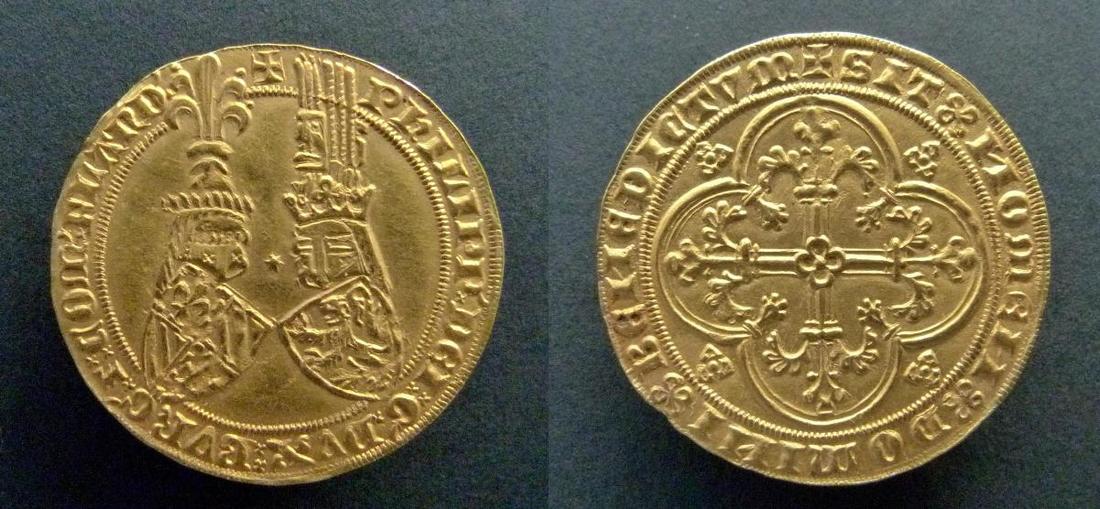On the obverse, two shields are tilted toward each other, as in a tournament. Above them are two helmets whose plumes, the decorative tops, cut across the coin's legend. The shield on the left bears the coat of arms known as “quartered Burgundy,” formed from ancient and modern Burgundy. It is surmounted by a helmet whose crest (the top) forms a fleur-de-lis. The shield on the right bears the coat of arms of Flanders, the rampant lion (heraldic term). It is a standing lion, its mouth open and its clawed paws ready to strike, as if in combat. This ornate shield is topped by a helmet whose crest is a roaring lion's mouth, framed by six feathers.
This helmet is reminiscent of the golden lion or helmeted lion, a Flemish coin minted by Louis de Mâle, the father-in-law of Philip the Bold. Between the two helmets, in the center of the field, is a spur wheel or six-pointed star.
The legend on the obverse indicates Philip's titles in Latin: “Duke of Burgundy, Count of Flanders by the grace of God” (and by his marriage to the heiress of Flanders!).
On the reverse, a cross with leafy ends is set in a large quatrefoil, flanked by four trefoils in its recessed corners. Its branches have three bands and its center bears a small quatrefoil with a central point.
The legend on the reverse reads in Latin: “Blessed be the name of the Lord.”

On the obverse, two shields are tilted toward each other, as in a tournament. Above them are two helmets whose plumes, the decorative tops, cut across the coin's legend. The shield on the left bears the coat of arms known as “quartered Burgundy,” formed from ancient and modern Burgundy. It is surmounted by a helmet whose crest (the top) forms a fleur-de-lis. The shield on the right bears the coat of arms of Flanders, the rampant lion (heraldic term). It is a standing lion, its mouth open and its clawed paws ready to strike, as if in combat. This ornate shield is topped by a helmet whose crest is a roaring lion's mouth, framed by six feathers.
This helmet is reminiscent of the golden lion or helmeted lion, a Flemish coin minted by Louis de Mâle, the father-in-law of Philip the Bold. Between the two helmets, in the center of the field, is a spur wheel or six-pointed star.
The legend on the obverse indicates Philip's titles in Latin: “Duke of Burgundy, Count of Flanders by the grace of God” (and by his marriage to the heiress of Flanders!).
On the reverse, a cross with leafy ends is set in a large quatrefoil, flanked by four trefoils in its recessed corners. Its branches have three bands and its center bears a small quatrefoil with a central point.
The legend on the reverse reads in Latin: “Blessed be the name of the Lord.”